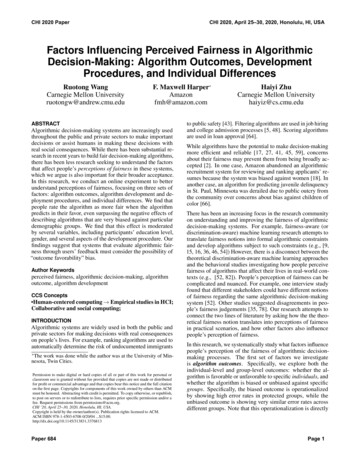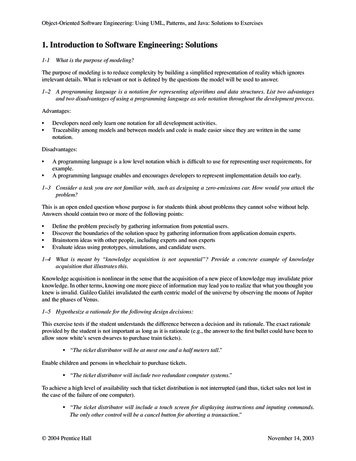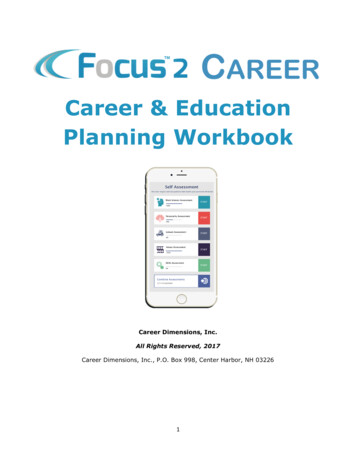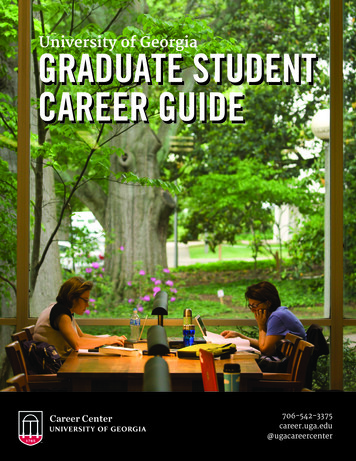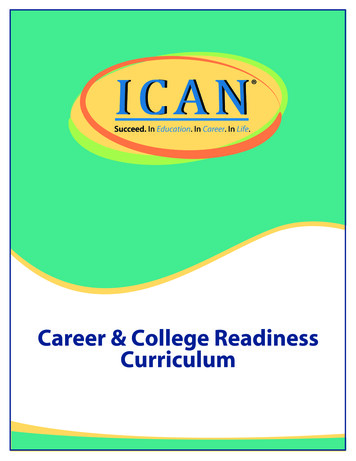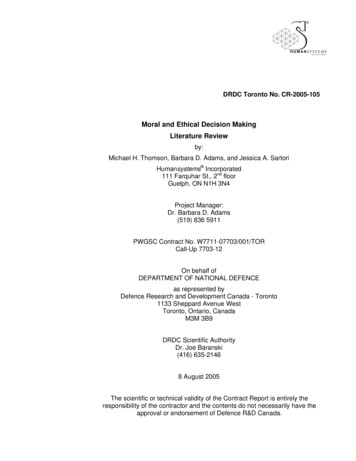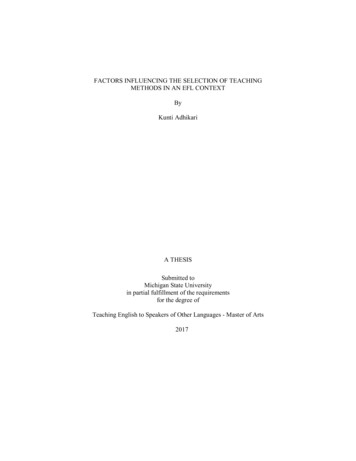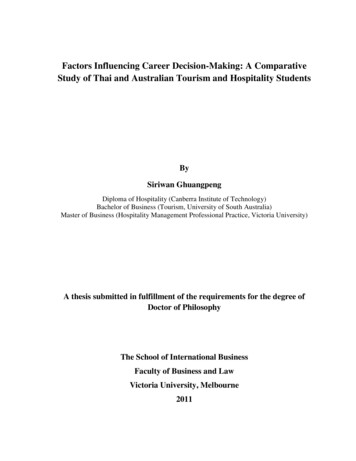
Transcription
Factors Influencing Career Decision-Making: A ComparativeStudy of Thai and Australian Tourism and Hospitality StudentsBySiriwan GhuangpengDiploma of Hospitality (Canberra Institute of Technology)Bachelor of Business (Tourism, University of South Australia)Master of Business (Hospitality Management Professional Practice, Victoria University)A thesis submitted in fulfillment of the requirements for the degree ofDoctor of PhilosophyThe School of International BusinessFaculty of Business and LawVictoria University, Melbourne2011
DECLARATIONI, Siriwan Ghuangpeng, declare that the PhD thesis entitled Factors Influencing CareerDecision-Making: A Comparative Study of Thai and Australian Tourism and HospitalityStudents is no more than 100,000 words in length, exclusive of tables, figures, appendices,references and footnotes. This thesis contains no material that has been submitted previously,in whole or in part, for the award of any other academic degree or diploma. Except whereotherwise indicated, this thesis is my own work.Siriwan Ghuangpengii
ACKNOWLEDGEMENTSI would like to take this opportunity to express my gratitude to all those who havecontributed in various ways and assisted me to undertake and complete this research. Someof these influences have enabled me to complete my PhD and others gave me the supportand opportunity to start my PhD studies.First, I would like to thank the Royal Thai Government and Mahasarakham University forthe financial support they provided to me during my PhD studies. I would like to sincerelythank my two supervisors, Associate Professor Susan Gillet and Associate Professor BarryO’Mahony. I would like to gratefully acknowledge their valuable time commitment andthank them for providing me with the guidance, feedback, and encouragement to keep memoving forward and to have confidence in my abilities to accomplish this research.I would also like to give special thanks to Assistant Professor Albert Assaf, who supervisedme whilst a lecturer at Victoria University and continued to generously and patiently assistme after he had resigned from the university to take up his position at the University ofMassachusetts Amherst. I am most thankful to him for his assistance with my data analysisand for the help and advice he gave me in terms of my data analysis and understanding ofmy results. His support enabled me to complete this thesis and to develop a betterunderstanding of quantitative research methods. I would also like to thank Mr. AustinNorman, my respected lecturer at Victoria University. I am grateful for his advice andencouragement, which were valuable beyond words.In addition, I would like to acknowledge the support given by a variety of academics andcolleagues who assisted me prior to and during the data collection in Australian andThailand. These included Dr. Thu-Huong Nguyen, Mr. Barry Broon, Ms. PatriciaHasenrader, Assistant Professor Thanet Srisathit, Dr. Suvenas Sophonsiri, Mr. PongphanSathatip, Mr. Ruengsin Ommeepean, Dr. Puangchompoo Sapjaroen, Ms. Lanna Supyen andMs. Parinda Jantori. Thank you so much, I really appreciate that you generously gave meyour time and support and enable me to undertake this research.iii
I am indebted to many of my friends and PhD colleagues who made my study much moreenjoyable. I wish to particularly acknowledge the assistance provided by two of my friendsand PhD colleagues who played an important role in this process–Pan and Proud. Theyencouraged me, pushed me, believed in me and most importantly were always there when Ineeded them.I also would like to acknowledge the help of family members in Thailand for their continuedsupport for whatever I chose to do. I especially want to thank my father, for his lifetime ofsacrifices, which have enabled me to reach this point. He has been my foundation and givenme strength throughout this PhD journey.Finally, I would like to express my gratitude to two of my high school teachers who startedme on this educational journey of achievement–Mrs. Kruawan Panyamee and Mrs.Rampuang Poopat. They went beyond their call of duty when teaching me to learn andhelping me to achieve. Without their dedication and encouragement, I would not have beengiven these academic opportunities. I know that I was very lucky to have been one of theirstudents.iv
ABSTRACTThe current study investigated what factors appear to drive the career decision-making ofThai and Australian tourism and hospitality students. This study was conducted to identifyvarious factors that Thai and Australian students perceived to play an important role in theirdecision to seek a career in the industry. It also sought to understand the way these factorsimpacted on Thai and Australians’ career decision-making and how their culturalinterpretations influenced their decision-making.Quantitative and qualitative methods were used to collect and analyse the data. Thequantitative study, which involved 818 questionnaires, was used to help identify the factorsthat Thai and Australian students perceived to be important. The qualitative study involved88 semi structured in-depth interviews and provided further explanations for how the factorssuggested by the quantitative study were interconnected and influenced career decisionmaking of Thai and Australian students.The findings identified several factors that were perceived to influence the career decisionmaking process of Thai and Australian students. Of particular importance were gender, thefeedback students received during work-placement, family obligations and careeropportunities in the industry. These factors appeared to be interrelated and could have apositive or negative impact on students’ decision to seek a career in the industry. The studyalso highlighted the important implications of culture for career decision-making andsuggested that although Thai and Australian students identified similar factors as influencingtheir career decision-making, they perceived the importance of these factors differently.The study concluded that career decision-making is a complicated process. Although thisstudy provided a structured model to demonstrate how students make their career decision, itis essential to recognise the complex range of factors associated with students’ decisions. Itshould also be recognised that since a case methodology was used this research should beregarded as a template for further research rather than as providing a definitive careerdecision-making model for tourism and hospitality students in Thailand and Australia.v
TABLE OF CONTENTSACKNOWLEDGEMENTS . iiiABSTRACT. vTABLE OF CONTENTS . viLIST OF TABLES. xiiLIST OF FIGURES. xivChapter One – An Overview . 151.1 Introduction. 151.2 Context of the Research. 151.3 Plan of the Thesis. 171.4 Conclusion . 19Chapter Two – Career Decision-Making: Theory and Research . 202.1 Introduction. 202.2 The Concept of Career Decision-Making. 202.3 Theoretical Approaches of Career Decision-Making . 212.3.1 Psychological Approaches to Career Decision-Making. 222.3.2 Sociological Approaches to Career Decision-Making . 272.3.3 Research into Career Decision-Making Theories . 342.4 The Context of Career Decision-Making Research. 362.4.1 Employee Perspectives. 362.4.2 Student Perspectives. 39vi
2.4.3 Cultural Influence on Individuals’ Career Decision-Making. 412.5 Conclusion . 43Chapter Three – Context of the Research . 443.1 Introduction. 443.2 Career Prospects in the Tourism and Hospitality Industry. 443.3 Career Paths within the Tourism and Hospitality Industry . 453.4 Career Development of Tourism and Hospitality Employees . 483.4.1 Individual Factors. 493.4.2 Environmental Factors . 523.4.3 Additional Factors Impacting upon Employees’ Career Success . 543.5 Factors Influencing Career Decision-Making in the Tourism and Hospitality Industry . 573.6 Limitations of Existing Research into Career Decision-Making. 623.7 Conclusion . 64Chapter Four – Theoretical Framework . 654.1 Introduction. 654.2 Proposed Theoretical Framework. 654.3 Orientation of the Current Research . 694.4 Theoretical Applications of the Current Research. 694.4.1 Applications of SCCT Model. 704.4.2 Applications of SCCT for an Understanding of Cultural Influences on the Tourismand Hospitality Students’ Career Decision-Making Process . 754.5 Conclusion . 77vii
Chapter Five – Research Methodology. 785.1 Introduction. 785.2 Research Design and Methods. 785.2.1 Developing Research Methods. 795.2.2 Choice of Research Methods: A Mixed Methods Approach . 805.2.3 The Implementation of Mixed Methods Research . 815.2.4 The Selection of Participants: A Case Study Research Strategy. 825.2.5 Translation for Research Instruments. 835.2.6 Rules on Ethics and Confidentiality. 845.3 The Quantitative Study . 855.3.1 Quantitative Research Method . 855.3.2 Data Collection. 895.3.3 Data Analysis . 905.4 The Qualitative Study . 925.4.1 Qualitative Research Method . 925.4.2 Data Collection. 945.4.3 Data Analysis . 965.5 Conclusion . 97Chapter Six – The Quantitative Study: Results and Discussion. 986.1 Introduction. 986.2 Data Collection and Preparations for the Quantitative Data Analysis . 996.3 An Overview of Tourism and Hospitality Students’ Profiles. 1016.3.1 Students’ Demographic Information . 1026.3.2 Students’ Work-placement Information . 104viii
6.3.3 Students’ Career Profiles. 1056.3.4 Summary . 1066.4 The Quantitative Results: Identification of Factors Associated with Students’ CareerDecision-Making Process. 1076.4.1 Exploring Students’ Career Decisions . 1076.4.2 Factors Associated with Students’ Career Decision-Making Process. 1136.4.3 Summary . 1196.5 Discussion. 1206.5.1 Individual factors (Gender and Age). 1206.5.2 Factor 2: Individuals’ Background Contextual Factors . 1226.5.3 Factor 3: Learning Experiences. 1236.5.4 Factor 4: Self-efficacy . 1236.5.5 Factor 5: Outcome Expectations . 1246.5.6 Factor 6: Career Interest . 1266.6 Conclusion . 126Chapter Seven – The Qualitative Study: Results . 1287.1 Introduction. 1287.2 Data Collection and Preparations for the Qualitative Data Analysis . 1297.3 Students’ Profiles. 1307.4 The Qualitative Results: Explanations for Career Decision-Making . 1327.4.1 What drives students’ decisions to enroll in a tourism and hospitality course?. 1337.4.2 What are the students’ expectations of their course and the industry? . 1397.4.3 The impact of the work-placement program on students’ perceptions towardscareers in the tourism and hospitality industry. 145ix
7.4.4 What drives students’ career decisions in the tourism and hospitality industry? 1617.4.5 Summary . 1727.5 Conclusion . 172Chapter Eight – The Qualitative Study: Discussion . 1738.1 Introduction. 1738.2 Explanations for Factors Associated with the Students’ Career Decision-Making. 1738.3 Discussion of the Qualitative Results . 1748.3.1 Factor 1: Individual Factors (Gender and Age). 1748.3.2 Factor 2: Individuals’ Background Contextual Factors . 1768.3.3 Factor 3: Learning Experiences. 1808.3.4 Factor 4: Self-efficacy . 1818.3.5 Factor 5: Outcome Expectations . 1858.3.6 Factor 6: Career Interest . 1878.3.7 The Relationship between Career Interest and Career Decision-Making . 1888.3.8 Cultural Interpretation of the Thai and Australian Tourism and HospitalityStudents on Career Decision-Making. 1918.4 Contributions of Qualitative Findings to the Quantitative Study . 1938.5 Conclusion . 195Chapter Nine – Conclusions and Implications . 1969.1 Introduction. 1969.2 An overview. 1969.3 The Key Findings . 1979.4 Contribution to Knowledge . 1999.4.1 Theory and Research in Career Decision-Making Perspectives . 200x
9.4.2 The Tourism and Hospitality Industry Perspectives . 2019.4.3 Cultural Perspectives . 2079.5 Limitations of the study and Recommendations for future research . 2089.6 Looking Forward . 210REFERENCES . 213APPENDICES. 227Appendix A: The Questionnaire Survey (English Version). 228Appendix B: The Questionnaire Survey (Thai Version). 233Appendix C: Students’ Work-placement Information . 238Appendix D: Questions for the Semi Structured In-depth Interview (English Version). 241Appendix E: Questions for the Semi Structured In-depth Interview. 243(Thai Version) . 243xi
LIST OF TABLESCHAPTER FOURTable 4.1 Some key differences between Thailand and Australia. 68CHAPTER SIXTable 6.1 Time and locations of data collection and the estimated total number of targetstudents. 100Table 6.2 A summary of the number of questionnaires and response rates obtained from thetarget universities . 102Table 6.3 Students’ demographic information . 103Table 6.4 Students’ decision to seek a career in the industry. 108Table 6.5 Students’ career decisions associated with gender and age. 108Table 6.6 Students’ career decisions associated with family background. 109Table 6.7 Students’ career decisions according to academic performance . 110Table 6.8 Students’ career decisions associated with work-placement satisfaction. 110Table 6.9 Students’ career decisions associated with work experience . 111Table 6.10 Relationship between students’ career interest and gender . 113Table 6.11 Construct Means, Standard Deviation and Reliability . 116Table 6.12 Regression Results. 117CHAPTER SEVENTable 7.1 Students’ profiles of the semi structured in-depth interviews . 131Table 7.2 Reasons for students enrolled into a tourism and hospitality course. 137xii
Table 7.3 Factors influencing the students’ decision to enroll in the tourism and hospitalitycourse . 138Table 7.4 Students’ expectations of their course and the tourism and hospitality industry 141Table 7.5 Accuracy of students’ perceptions of their course and the industry. 142Table 7.6 Students’ ideal jobs. 145Table 7.7 Students’ work-placement profiles . 146Table 7.8 The perceived importance of the work-placement program. 147Table 7.9 Issues associated with students’ perceived importance of the work-placementprogram . 148Table 7.10 Students’ work-placement experience. 150Table 7.11 Factors associated with students’ work-placement experience . 151Table 7.12 Relationship between students’ work-placement satisfaction and their jobintentions . 153Table 7.13 Relationship between job positions and students’ intention to apply for the job. 154Table 7.14 Factors influencing students’ intentions for applying for the job completed duringtheir work-placement program . 156Table 7.15 Factors associated with students’ career decision . 162Table 7.16 Factors influencing students who seek a career in the tourism and hospitalityindustry. 167Table 7.17 Factors influencing students who do not seek a career in the tourism andhospitality industry. 171xiii
LIST OF FIGURESCHAPTER TWOFigure 2.1The conditional relationships between efficacy beliefs, and outcomeexpectations .28Figure 2.2Model of person, contextual and experimental factors affectingcareer-related of choice behaviour .32CHAPTER TREEFigure 3.1Career paths within tourism industry .45CHAPTER FOURFigure 4.2Application of SCCT’s model on the current research .75CHAPTER FIVEFigure 5.1Sequential explanatory design . .81Figure 5.2Sampling strategies used to recruit participants for the qualitative study .95xiv
Chapter OneAn Overview1.1 IntroductionThis chapter provides an overview of the current study which discusses the importance ofunderstanding why some tourism and hospitality students seek a long-term career within thetourism and hospitality industry and why others select alternative careers. It also exploresand identifies factors relevant to the career decision-making process of tourism andhospitality students within a Thai and an Australian context. This chapter includes researchbackground, key issues and assumptions of the study, primary purposes, and the thesis plan.1.2 Context of the ResearchThe tourism and hospitality industry is one of the fastest growing industries worldwide. It isreported that the industry represented approximately 3 per cent of the world’s total labourforce in 1999 (International Labour Organisation 2001) and rose to approximately 8 per centand created more than 235 million jobs globally in 2010 (International Labour Organisation2010). Although this rapid growth has provided greater employment opportunities in theindustry, previous studies have indicated that despite high demand for employees, theindustry has long been experiencing difficulties in retaining employees (Boella & GossTurner 2005; Wood 1997). Similarly, early research exploring careers in the tourism andhospitality industry among tourism and hospitality students also indicated that a highproportion of students expressed little interest in pursuing a career in the industry aftergraduation (Jenkins 2001; Rudall, Deery & Stewart 1996). As a result, the tourism andhospitality industry and education practitioners have sought to understand what drives careerdecision-making in the tourism and hospitality industry (Jiang & Tribe 2009; Richardson2009).15
Based on previous studies of career decision-making in the tourism and hospitality industry,several key issues and assumptions are underlined.Previous career decision-making studies have sought to identify a number of single factorsthat may influence an employee’s decision to either leave the industry or pursue a long-termcareer within the tourism and hospitality industry. These include employees’ perceived jobsatisfaction (Lam, Baum & Pine 2001), gender (Purcell 1996), personality traits (Stone &Ineson 1997), the nature of tourism and hospitality work (Birdir 2002; Littlejohn & Watson2004), seasonality (Jolliffe & Farnsworth 2003) and economic environment (Wong 2004).The weakness of this approach is that it does not assist tourism and hospitality employees tounderstand the interrelationship or importance of factors, or enable the industry to providemeaningful career paths for employees. As a result, it is essential to develop a broadperspective, and one useful approach in doing this is to consider career decision-making as aprocess. This allows a variety of important factors, both individual and environmental, to beidentified and could be used to demonstrate the interrelation of these factors and how theyinfluence career decision-making in the tourism and hospitality industry.In addition, a review of the literature suggests that cultural values towards a career in thetourism and hospitality industry in different countries can have a significant influence on anemployee’s career decision-making process. For example, in South-East Asian countriessuch as Thailand and Indonesia, working in the accommodation sector (e.g. hotels andresorts) is perceived positively, as it is easier work than unskilled work in other industriessuch as construction, transportation, or manufacturing. Whereas, in Singapore, Hong Kongand Brunei, the industry appears to have difficulty attracting hotel workers because thesecountries, culturally, perceive serving people as degrading work and therefore working in ahotel can be seen as a low status job (Nankervis 2002). Accordingly, it can be seen thatcultural values can either encourage or discourage people from working in the tourism andhospitality industry. It i
also highlighted the important implications of culture for career decision-making and suggested that although Thai and Australian students identified similar factors as influencing their career decision-making, they perceived the importance of these factors differently. The study concluded that career decision-making is a complicated process.
